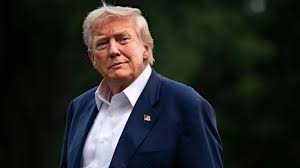Trump’s first tranche of tariffs comes into effect, hitting over 90 countries

Washington, D.C. – August 7, 2025:
Former President Donald Trump’s first wave of tariffs is now in effect. These new duties apply to products from over 90 countries, marking a sharp return to his “America First 2.0” trade agenda. The tariffs are already shaking global markets and raising fears of renewed trade tensions.
These duties range from 10% to 60%. They apply to automobiles, electronics, steel, machinery, clothing, and agricultural products. Countries facing the hardest hit include China, Germany, India, Brazil, and even key U.S. allies such as Canada and Japan.
A New Push for Protectionism
Trump is reviving his earlier trade policies as part of a renewed bid for the White House. His campaign argues that decades of weak trade enforcement have damaged American jobs. The tariffs, they say, are designed to reverse this.
“This isn’t about punishing others,” Trump said at a rally in Ohio. “It’s about finally putting American workers first.”
This strategy mirrors his 2017–2020 policies but on a broader scale. Economists believe this move could change trade relationships for years to come.
Who Will Feel the Impact?
The U.S. Trade Representative released a list of 93 countries affected by the tariffs. The duties apply to a wide range of goods:
- Steel and aluminum from Canada, South Korea, and Brazil
- Vehicles and parts from Germany, Japan, and Mexico
- Smartphones and electronics from China, Taiwan, and Vietnam
- Coffee, sugar, and grains from Latin America
- Textiles from Bangladesh, India, and Indonesia
Exporters face a choice: pay higher costs or risk losing access to the U.S. market.
International Response: Backlash and Retaliation
Several countries are already planning countermeasures. The European Union says it will introduce new tariffs on American goods like motorcycles, whiskey, and soybeans.
China’s Ministry of Commerce called the move “a violation of fair trade principles.” It pledged to protect its interests with its own actions.
India, Australia, and South Africa also criticized the decision. They called it harmful, unilateral, and dangerous for global trade.
“We are seeing trade tensions rise quickly,” said Mark Heller, a senior trade expert. “There’s no sign of diplomatic solutions on the table.”
Impact on U.S. Businesses and Consumers
Inside the U.S., the reaction is mixed. Some manufacturers and labor unions support the tariffs. They say it helps protect American jobs and factories.
But many retailers, tech companies, and small businesses are worried. They warn that prices will go up and inventories may shrink.
Walmart and Target have already warned of likely price increases. Ford and Tesla are expecting delays and higher costs for car production.
“These tariffs will hurt American shoppers,” said Julie Kendrick of the National Retail Federation. “Factories may benefit, but consumers will pay the price.”
Small businesses are facing tough choices: raise prices, reduce inventory, or absorb losses.
Stock Market and Economic Risks
Markets have shown clear concern. The Dow Jones dropped 1.5% on the day the tariffs began. The NASDAQ, with its tech-heavy listings, also saw losses.
Companies that depend on imports or exports are seeing the worst of the fallout. Investor confidence in those sectors has dropped sharply.
Globally, many economies that rely on exports may face inflation and slower growth.
The World Bank warned the trade conflict could cut global GDP growth by up to 0.7% in 2026.
What Could Come Next?
Trump’s advisers say this is just the start. More tariffs could follow, possibly on digital services, pharmaceuticals, and clean energy parts.
Some are discussing a 10% tariff on all imports, which Trump has suggested in interviews.
Such steps could trigger more legal challenges through the World Trade Organization. They could also worsen ties with key trading partners. Still, Trump seems determined to press ahead.
“We tried free trade. It didn’t work,” he told supporters in Michigan. “Now we’re putting America back in control.”
Final Thoughts
Trump’s tariff plan is already changing the global trade map. Over 90 countries are affected. More disruptions are likely in the months ahead.
The impact won’t just be economic. Political tensions could rise. Diplomatic relationships may suffer. And businesses across the globe will have to adapt fast.
The return to aggressive tariffs could mark the end of an era of open trade—and the start of a more divided global economy.






